中秋节起源英文介绍
中秋节起源英语介绍
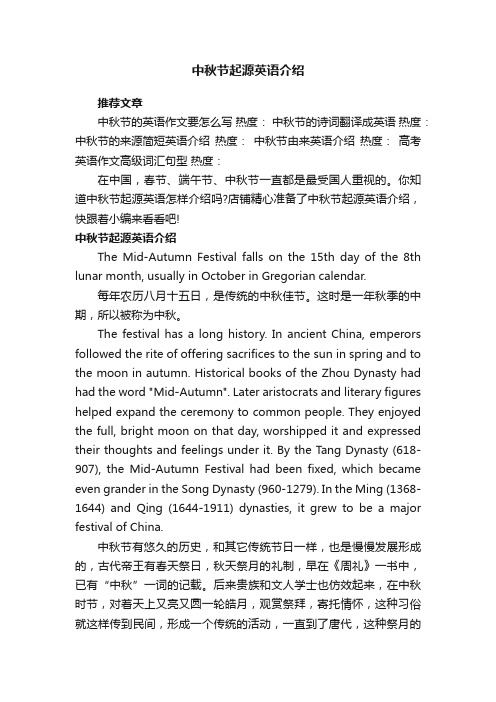
中秋节起源英语介绍推荐文章中秋节的英语作文要怎么写热度:中秋节的诗词翻译成英语热度:中秋节的来源简短英语介绍热度:中秋节由来英语介绍热度:高考英语作文高级词汇句型热度:在中国,春节、端午节、中秋节一直都是最受国人重视的。
你知道中秋节起源英语怎样介绍吗?店铺精心准备了中秋节起源英语介绍,快跟着小编来看看吧!中秋节起源英语介绍The Mid-Autumn Festival falls on the 15th day of the 8th lunar month, usually in October in Gregorian calendar.每年农历八月十五日,是传统的中秋佳节。
这时是一年秋季的中期,所以被称为中秋。
The festival has a long history. In ancient China, emperors followed the rite of offering sacrifices to the sun in spring and to the moon in autumn. Historical books of the Zhou Dynasty had had the word "Mid-Autumn". Later aristocrats and literary figures helped expand the ceremony to common people. They enjoyed the full, bright moon on that day, worshipped it and expressed their thoughts and feelings under it. By the Tang Dynasty (618-907), the Mid-Autumn Festival had been fixed, which became even grander in the Song Dynasty (960-1279). In the Ming (1368-1644) and Qing (1644-1911) dynasties, it grew to be a major festival of China.中秋节有悠久的历史,和其它传统节日一样,也是慢慢发展形成的,古代帝王有春天祭日,秋天祭月的礼制,早在《周礼》一书中,已有“中秋”一词的记载。
中秋节的起源英语版
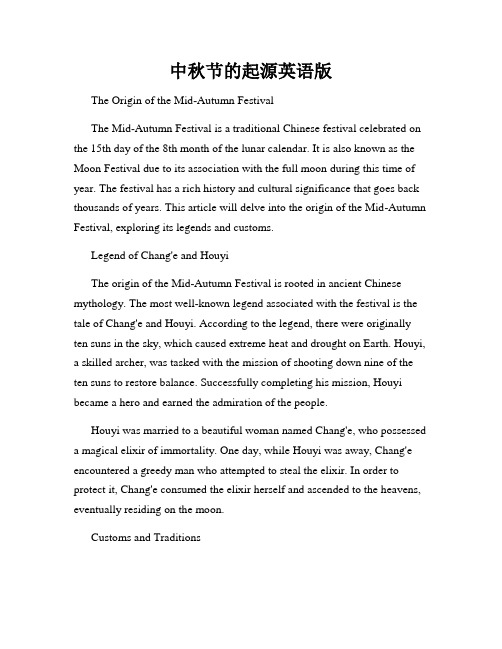
中秋节的起源英语版The Origin of the Mid-Autumn FestivalThe Mid-Autumn Festival is a traditional Chinese festival celebrated on the 15th day of the 8th month of the lunar calendar. It is also known as the Moon Festival due to its association with the full moon during this time of year. The festival has a rich history and cultural significance that goes back thousands of years. This article will delve into the origin of the Mid-Autumn Festival, exploring its legends and customs.Legend of Chang'e and HouyiThe origin of the Mid-Autumn Festival is rooted in ancient Chinese mythology. The most well-known legend associated with the festival is the tale of Chang'e and Houyi. According to the legend, there were originally ten suns in the sky, which caused extreme heat and drought on Earth. Houyi, a skilled archer, was tasked with the mission of shooting down nine of the ten suns to restore balance. Successfully completing his mission, Houyi became a hero and earned the admiration of the people.Houyi was married to a beautiful woman named Chang'e, who possessed a magical elixir of immortality. One day, while Houyi was away, Chang'e encountered a greedy man who attempted to steal the elixir. In order to protect it, Chang'e consumed the elixir herself and ascended to the heavens, eventually residing on the moon.Customs and TraditionsThe Mid-Autumn Festival is celebrated with various customs and traditions that have been passed down through generations. One of the most iconic symbols of the festival is the mooncake, a round pastry filled with sweet lotus seed or bean paste. Mooncakes are often exchanged among family members and friends as tokens of well wishes and reunion.Another popular custom is to admire the full moon during the festival night. Family and friends gather together in open areas, such as parks or rooftops, to appreciate the beauty of the moon. Lanterns in various shapes and sizes, including traditional red lanterns and intricately designed ones, are also displayed during this time.It is believed that the full moon on the Mid-Autumn Festival night symbolizes unity and harmony. This is why the festival is often seen as a time for family reunion. Many people travel long distances to be with their loved ones on this special day, sharing a meal and enjoying each other's company.Furthermore, the Mid-Autumn Festival is a significant time for expressing gratitude and showing respect to one's ancestors. It is customary to offer food and fruit to the deceased during this time, honoring their memory and seeking blessings from the spiritual realm.Celebrations Around the WorldThe Mid-Autumn Festival is not only celebrated in China, but also in various other Asian countries and regions with Chinese communities. In these places, cultural activities such as lantern parades, dragon dances, and traditional music performances are held to commemorate the festival.In recent years, the Mid-Autumn Festival has gained recognition and popularity globally. Its significance as a time for family reunion, cultural exchange, and appreciation of the moon's beauty has resonated with people from different backgrounds. Many people, regardless of their cultural heritage, join in the celebrations by tasting mooncakes, learning about the legends, and experiencing the festive atmosphere.In conclusion, the Mid-Autumn Festival is a significant traditional Chinese festival with a rich history and cultural importance. Its origin can be traced back to legends such as Chang'e and Houyi, while its customs and traditions have been passed down through generations. Celebrated on the 15th day of the 8th lunar month, the festival brings families together, encourages gratitude, and fosters unity. As the moon shines brightly on this special night, people from all over the world join in the festivities, embracing the spirit of the Mid-Autumn Festival.。
中秋节来历英文(10篇)

中秋节来历英文(10篇)(经典版)编制人:__________________审核人:__________________审批人:__________________编制单位:__________________编制时间:____年____月____日序言下载提示:该文档是本店铺精心编制而成的,希望大家下载后,能够帮助大家解决实际问题。
文档下载后可定制修改,请根据实际需要进行调整和使用,谢谢!并且,本店铺为大家提供各种类型的经典范文,如合同协议、演讲致辞、述职报告、心得体会、工作总结、工作计划、自我鉴定、教学资料、作文大全、其他范文等等,想了解不同范文格式和写法,敬请关注!Download tips: This document is carefully compiled by this editor. I hope that after you download it, it can help you solve practical problems. The document can be customized and modified after downloading, please adjust and use it according to actual needs, thank you!Moreover, our store provides various types of classic sample essays, such as contract agreements, speeches, job reports, insights, work summaries, work plans, self-evaluation, teaching materials, complete essays, and other sample essays. If you want to learn about different sample formats and writing methods, please pay attention!中秋节来历英文(10篇)中秋节是中国最重要的节日之一。
英文介绍中秋节的来历作文
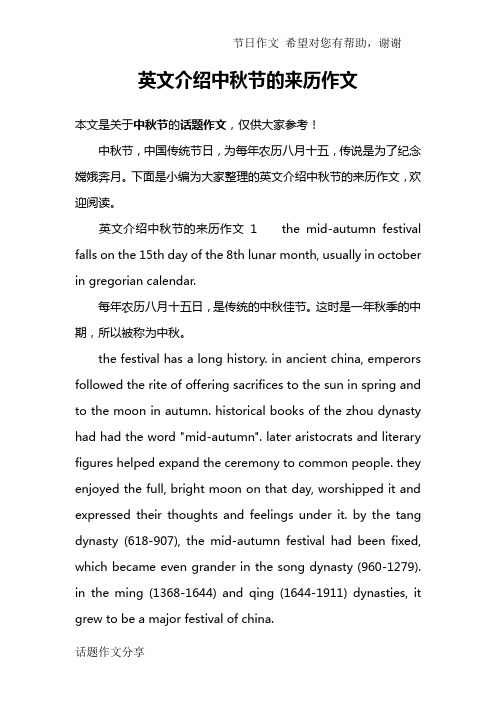
英文介绍中秋节的来历作文本文是关于中秋节的话题作文,仅供大家参考!中秋节,中国传统节日,为每年农历八月十五,传说是为了纪念嫦娥奔月。
下面是小编为大家整理的英文介绍中秋节的来历作文,欢迎阅读。
英文介绍中秋节的来历作文1 the mid-autumn festival falls on the 15th day of the 8th lunar month, usually in october in gregorian calendar.每年农历八月十五日,是传统的中秋佳节。
这时是一年秋季的中期,所以被称为中秋。
the festival has a long history. in ancient china, emperors followed the rite of offering sacrifices to the sun in spring and to the moon in autumn. historical books of the zhou dynasty had had the word "mid-autumn". later aristocrats and literary figures helped expand the ceremony to common people. they enjoyed the full, bright moon on that day, worshipped it and expressed their thoughts and feelings under it. by the tang dynasty (618-907), the mid-autumn festival had been fixed, which became even grander in the song dynasty (960-1279). in the ming (1368-1644) and qing (1644-1911) dynasties, it grew to be a major festival of china.中秋节有悠久的历史,和其它传统节日一样,也是慢慢发展形成的,古代帝王有春天祭日,秋天祭月的礼制,早在《周礼》一书中,已有“中秋”一词的记载。
中秋节起源英语介绍
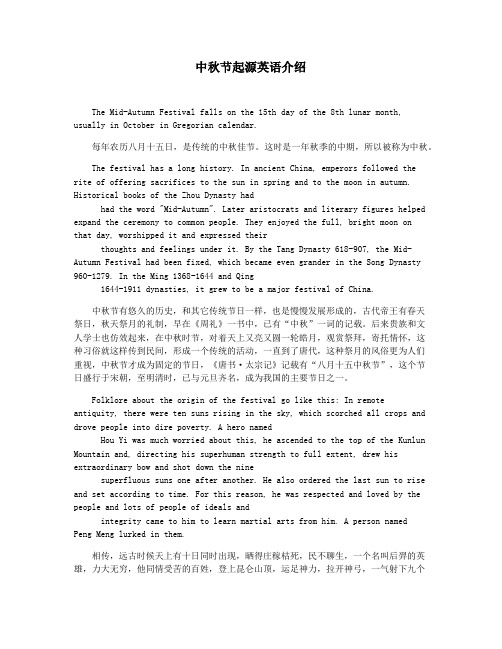
中秋节起源英语介绍The Mid-Autumn Festival falls on the 15th day of the 8th lunar month, usually in October in Gregorian calendar.每年农历八月十五日,是传统的中秋佳节。
这时是一年秋季的中期,所以被称为中秋。
The festival has a long history. In ancient China, emperors followed therite of offering sacrifices to the sun in spring and to the moon in autumn. Historical books of the Zhou Dynasty hadhad the word "Mid-Autumn". Later aristocrats and literary figures helped expand the ceremony to common people. They enjoyed the full, bright moon onthat day, worshipped it and expressed theirthoughts and feelings under it. By the Tang Dynasty 618-907, the Mid-Autumn Festival had been fixed, which became even grander in the Song Dynasty 960-1279. In the Ming 1368-1644 and Qing1644-1911 dynasties, it grew to be a major festival of China.中秋节有悠久的历史,和其它传统节日一样,也是慢慢发展形成的,古代帝王有春天祭日,秋天祭月的礼制,早在《周礼》一书中,已有“中秋”一词的记载。
用英文介绍中国的中秋节简短
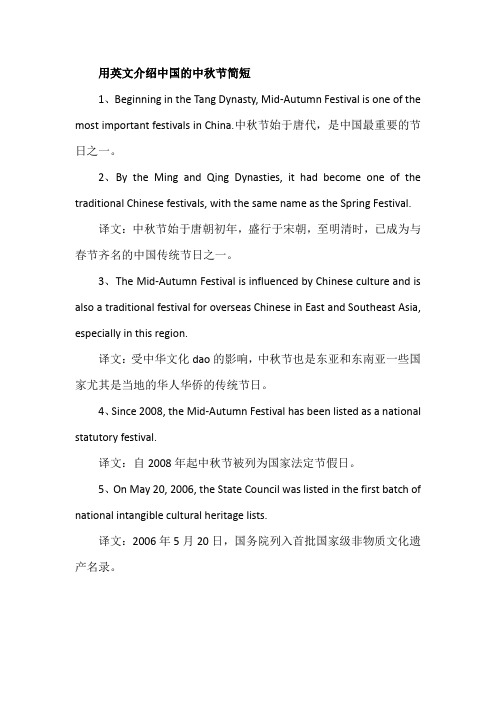
用英文介绍中国的中秋节简短1、Beginning in the Tang Dynasty, Mid-Autumn Festival is one of the most important festivals in China.中秋节始于唐代,是中国最重要的节日之一。
2、By the Ming and Qing Dynasties, it had become one of the traditional Chinese festivals, with the same name as the Spring Festival.译文:中秋节始于唐朝初年,盛行于宋朝,至明清时,已成为与春节齐名的中国传统节日之一。
3、The Mid-Autumn Festival is influenced by Chinese culture and is also a traditional festival for overseas Chinese in East and Southeast Asia, especially in this region.译文:受中华文化dao的影响,中秋节也是东亚和东南亚一些国家尤其是当地的华人华侨的传统节日。
4、Since 2008, the Mid-Autumn Festival has been listed as a national statutory festival.译文:自2008年起中秋节被列为国家法定节假日。
5、On May 20, 2006, the State Council was listed in the first batch of national intangible cultural heritage lists.译文:2006年5月20日,国务院列入首批国家级非物质文化遗产名录。
中秋节的起源用英文怎样介绍
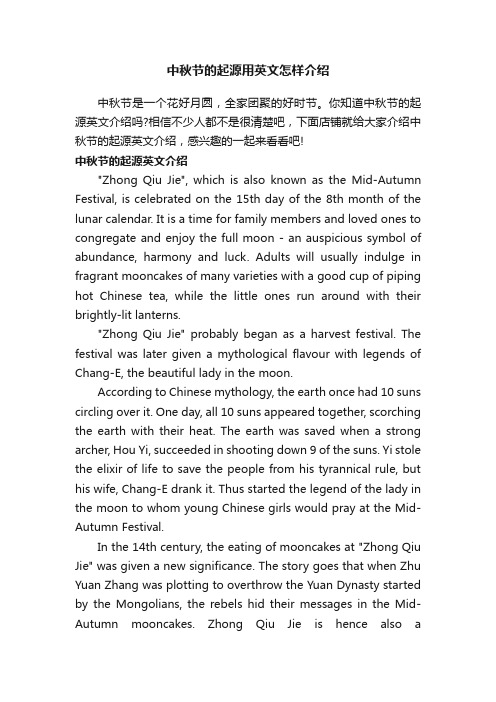
中秋节的起源用英文怎样介绍中秋节是一个花好月圆,全家团聚的好时节。
你知道中秋节的起源英文介绍吗?相信不少人都不是很清楚吧,下面店铺就给大家介绍中秋节的起源英文介绍,感兴趣的一起来看看吧!中秋节的起源英文介绍"Zhong Qiu Jie", which is also known as the Mid-Autumn Festival, is celebrated on the 15th day of the 8th month of the lunar calendar. It is a time for family members and loved ones to congregate and enjoy the full moon - an auspicious symbol of abundance, harmony and luck. Adults will usually indulge in fragrant mooncakes of many varieties with a good cup of piping hot Chinese tea, while the little ones run around with their brightly-lit lanterns."Zhong Qiu Jie" probably began as a harvest festival. The festival was later given a mythological flavour with legends of Chang-E, the beautiful lady in the moon.According to Chinese mythology, the earth once had 10 suns circling over it. One day, all 10 suns appeared together, scorching the earth with their heat. The earth was saved when a strong archer, Hou Yi, succeeded in shooting down 9 of the suns. Yi stole the elixir of life to save the people from his tyrannical rule, but his wife, Chang-E drank it. Thus started the legend of the lady in the moon to whom young Chinese girls would pray at the Mid-Autumn Festival.In the 14th century, the eating of mooncakes at "Zhong Qiu Jie" was given a new significance. The story goes that when Zhu Yuan Zhang was plotting to overthrow the Yuan Dynasty started by the Mongolians, the rebels hid their messages in the Mid-Autumn mooncakes. Zhong Qiu Jie is hence also acommemoration of the overthrow of the Mongolians by the Han people.During the Yuan Dynasty (A.D.1206-1368) China was ruled by the Mongolian people. Leaders from the preceding Sung Dynasty(A.D.960-1279) were unhappy at submitting to foreign rule, and set how to coordinate the rebellion without it being discovered. The leaders of the rebellion, knowing that the Moon Festival was drawing near, ordered the making of special cakes. Packed into each mooncake was a message with the outline of the attack. On the night of the Moon Festival, the rebels successfully attacked and overthrew the government. What followed was the establishment of the Ming Dynasty (A.D. 1368-1644). Today, moon cakes are eaten to commemorate this event.Mid-Autumn Day is a traditional festival in China. Almost everyone likes to eat mooncakes on that day. Most families have a dinner together to celebrate the festival. A saying goes, "The moon in your hometown is almost always the brightest and roundest". Many people who live far away from homes want to go back to have a family reunion. How happy it is to enjoy the moon cakes while watching the full moon with your family members.中秋节各地习俗河北省万全县称中秋为“小元旦”,月光纸上绘有太阴星君及关帝夜阅春秋像。
中秋节的起源英文简单介绍
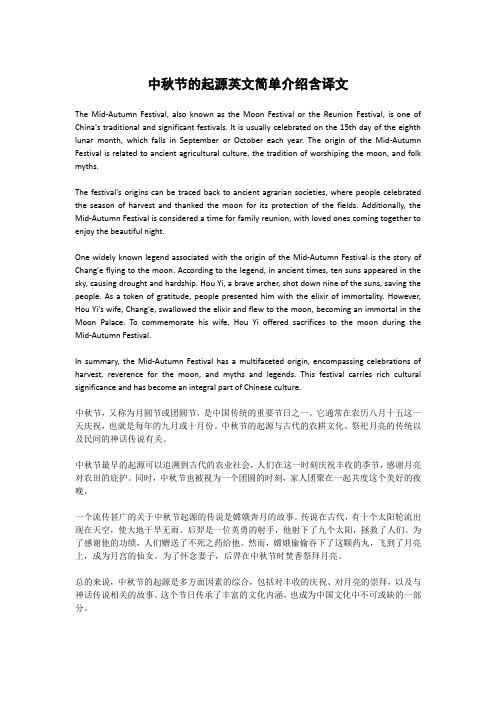
中秋节的起源英文简单介绍含译文The Mid-Autumn Festival, also known as the Moon Festival or the Reunion Festival, is one of China's traditional and significant festivals. It is usually celebrated on the 15th day of the eighth lunar month, which falls in September or October each year. The origin of the Mid-Autumn Festival is related to ancient agricultural culture, the tradition of worshiping the moon, and folk myths.The festival's origins can be traced back to ancient agrarian societies, where people celebrated the season of harvest and thanked the moon for its protection of the fields. Additionally, the Mid-Autumn Festival is considered a time for family reunion, with loved ones coming together to enjoy the beautiful night.One widely known legend associated with the origin of the Mid-Autumn Festival is the story of Chang'e flying to the moon. According to the legend, in ancient times, ten suns appeared in the sky, causing drought and hardship. Hou Yi, a brave archer, shot down nine of the suns, saving the people. As a token of gratitude, people presented him with the elixir of immortality. However, Hou Yi's wife, Chang'e, swallowed the elixir and flew to the moon, becoming an immortal in the Moon Palace. To commemorate his wife, Hou Yi offered sacrifices to the moon during the Mid-Autumn Festival.In summary, the Mid-Autumn Festival has a multifaceted origin, encompassing celebrations of harvest, reverence for the moon, and myths and legends. This festival carries rich cultural significance and has become an integral part of Chinese culture.中秋节,又称为月圆节或团圆节,是中国传统的重要节日之一。
中秋节的来历英文版
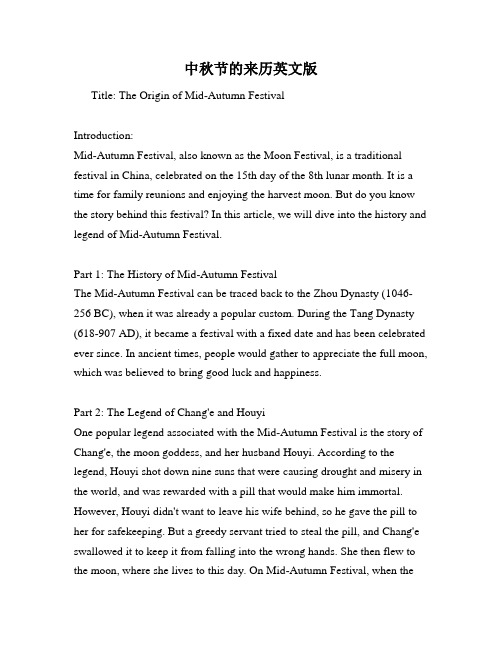
中秋节的来历英文版Title: The Origin of Mid-Autumn FestivalIntroduction:Mid-Autumn Festival, also known as the Moon Festival, is a traditional festival in China, celebrated on the 15th day of the 8th lunar month. It is a time for family reunions and enjoying the harvest moon. But do you know the story behind this festival? In this article, we will dive into the history and legend of Mid-Autumn Festival.Part 1: The History of Mid-Autumn FestivalThe Mid-Autumn Festival can be traced back to the Zhou Dynasty (1046-256 BC), when it was already a popular custom. During the Tang Dynasty (618-907 AD), it became a festival with a fixed date and has been celebrated ever since. In ancient times, people would gather to appreciate the full moon, which was believed to bring good luck and happiness.Part 2: The Legend of Chang'e and HouyiOne popular legend associated with the Mid-Autumn Festival is the story of Chang'e, the moon goddess, and her husband Houyi. According to the legend, Houyi shot down nine suns that were causing drought and misery in the world, and was rewarded with a pill that would make him immortal. However, Houyi didn't want to leave his wife behind, so he gave the pill to her for safekeeping. But a greedy servant tried to steal the pill, and Chang'e swallowed it to keep it from falling into the wrong hands. She then flew to the moon, where she lives to this day. On Mid-Autumn Festival, when themoon is at its fullest, people honor Chang'e and her sacrifice by offering mooncakes and praying for good luck and blessings.Part 3: Celebrating Mid-Autumn Festival TodayToday, Mid-Autumn Festival is still a time for family reunions, as people travel from all over to be together on this special day. They enjoy traditional foods, such as mooncakes and pomelos, and participate in activities such as lantern lightings and dragon dances. It is also a time to reflect on the importance of family, friends, and community.In conclusion, the Mid-Autumn Festival has a rich history and legend that has been passed down through generations. It is an important cultural festival that is still celebrated with great enthusiasm by people all over the world. Let's cherish this festival and the traditions that bring us together.。
中秋节节日英文介绍
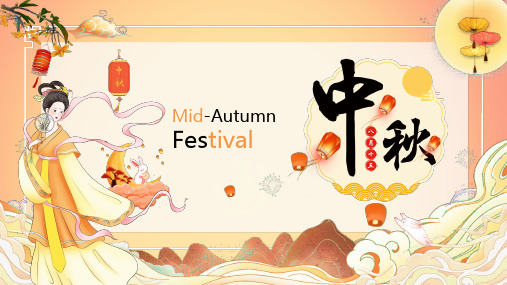
中秋节有三千多年历史,可以追溯到商代时对月亮的崇拜。因为中秋节 的重要地位,历代诗人都会为中秋节写诗,关于中秋节的故事、传奇在 民间广为流传,中秋节的起源也被历代中国人探究。
The origin of the Mid-Autumn Festival 中秋起源
The term "Mid-Autumn" first appeared in the book Rites of Zhou (周礼), written in the Warring States Period (475–221 BC). But the term only related to the time and season; the festival didn't exist at that point. “中秋”一词最早出现在战国时期《周礼》一书中,但是该词只和时间和季节有关,当时还没有中秋节。 In the Tang Dynasty (618–907 AD), it was popular to appreciate the moon. Many poets liked to create poems related to the moon when appreciating it. There is a legend that Emperor Xuanzong of the Tang Dynasty visited the Moon Palace in his dream and heard a wonderful song.
中秋节的来历和风俗 英文版
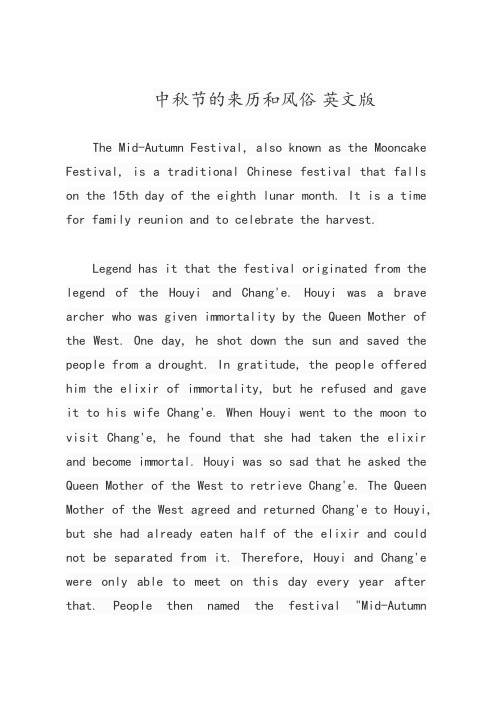
中秋节的来历和风俗英文版The Mid-Autumn Festival, also known as the Mooncake Festival, is a traditional Chinese festival that falls on the 15th day of the eighth lunar month. It is a time for family reunion and to celebrate the harvest.Legend has it that the festival originated from the legend of the Houyi and Chang'e. Houyi was a brave archer who was given immortality by the Queen Mother of the West. One day, he shot down the sun and saved the people from a drought. In gratitude, the people offered him the elixir of immortality, but he refused and gave it to his wife Chang'e. When Houyi went to the moon to visit Chang'e, he found that she had taken the elixir and become immortal. Houyi was so sad that he asked the Queen Mother of the West to retrieve Chang'e. The Queen Mother of the West agreed and returned Chang'e to Houyi, but she had already eaten half of the elixir and could not be separated from it. Therefore, Houyi and Chang'e were only able to meet on this day every year after that. People then named the festival "Mid-AutumnFestival" in honor of their reunion on this day.The Mid-Autumn Festival is a festival filled with symbols and legends. It is said that Chang'e took pity on people who worked hard and lonely all year round and put out her candle at midnight for them on the 15th day of the eighth lunar month each year. Therefore, people call this day "Mid-Autumn Festival" because it is in the middle of autumn.The Mid-Autumn Festival is a festival with many customs. One of them is to eat mooncakes, which are round cakes with a diameter of about 20 cm and weighing about 500 grams. The filling inside is usually sweetened bean paste, lotus seed paste, egg yolk, or fruit. The top is often decorated with a rabbit or Chang'e's image to symbolize reunion and peace. Another custom is to look at the moon and admire its beauty. On this day, people often go outdoors and have a feast under the clear moon. The bright moon at this time often reminds people of their family members and loved ones far away, which has given rise to many beautifulsongs and poems about missing people and family reunion.。
中秋节的来历介绍英文版
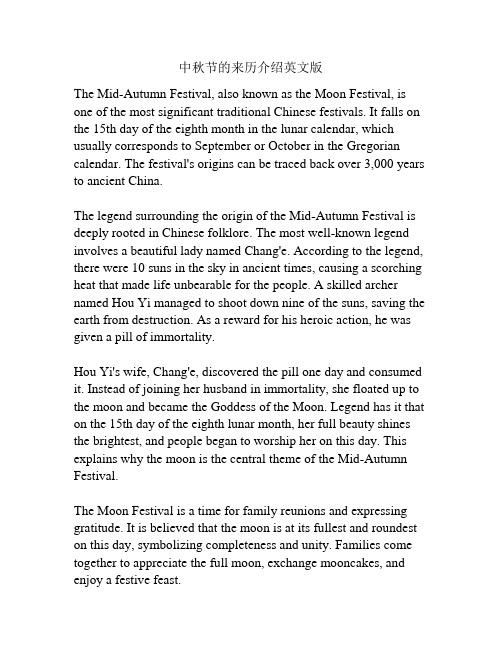
中秋节的来历介绍英文版The Mid-Autumn Festival, also known as the Moon Festival, is one of the most significant traditional Chinese festivals. It falls on the 15th day of the eighth month in the lunar calendar, which usually corresponds to September or October in the Gregorian calendar. The festival's origins can be traced back over 3,000 years to ancient China.The legend surrounding the origin of the Mid-Autumn Festival is deeply rooted in Chinese folklore. The most well-known legend involves a beautiful lady named Chang'e. According to the legend, there were 10 suns in the sky in ancient times, causing a scorching heat that made life unbearable for the people. A skilled archer named Hou Yi managed to shoot down nine of the suns, saving the earth from destruction. As a reward for his heroic action, he was given a pill of immortality.Hou Yi's wife, Chang'e, discovered the pill one day and consumed it. Instead of joining her husband in immortality, she floated up to the moon and became the Goddess of the Moon. Legend has it that on the 15th day of the eighth lunar month, her full beauty shines the brightest, and people began to worship her on this day. This explains why the moon is the central theme of the Mid-Autumn Festival.The Moon Festival is a time for family reunions and expressing gratitude. It is believed that the moon is at its fullest and roundest on this day, symbolizing completeness and unity. Families come together to appreciate the full moon, exchange mooncakes, and enjoy a festive feast.Mooncakes are a traditional delicacy during the Mid-Autumn Festival. They are circular pastries that come in a variety of flavors and fillings, such as lotus seed paste, red bean paste, and salted egg yolk. The round shape of the mooncake represents the full moon, while the stuffing inside symbolizes the reunion of family.In addition to mooncakes, other traditional activities are associated with the Mid-Autumn Festival. Lanterns are a common sight during this time, and children enjoy carrying lighted lanterns in various shapes and sizes. Some lanterns are crafted to resemble animals or mythical creatures. The lanterns add a vibrant and festive atmosphere to the celebration.Another popular activity during the Moon Festival is moon gazing. People gather outdoors, often in open parks or gardens, to appreciate the beauty of the moon. Some even compose poems or songs about the moon, expressing their emotions and desires.The tradition of the Mid-Autumn Festival has been passed down through generations, and it continues to be an important cultural event in China and other East Asian countries. It is a time for families to come together, celebrate their bonds, and pay homage to the moon. The festival's unique legends, delicious mooncakes, and enchanting lanterns all contribute to its enduring charm and popularity.。
中秋节来历的英文介绍
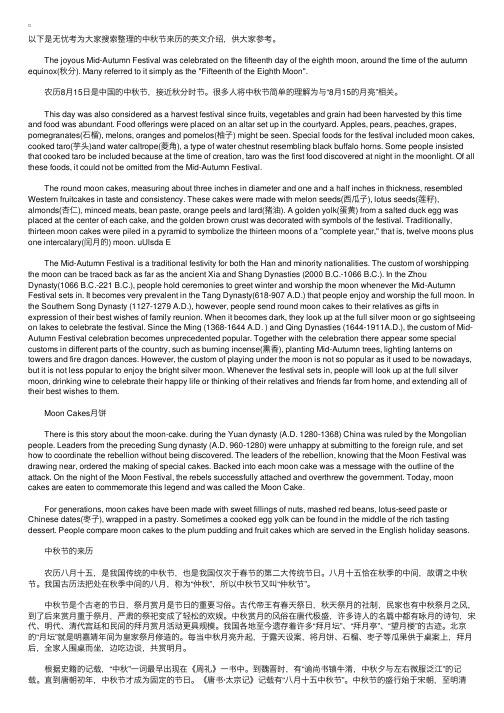
以下是⽆忧考为⼤家搜索整理的中秋节来历的英⽂介绍,供⼤家参考。
The joyous Mid-Autumn Festival was celebrated on the fifteenth day of the eighth moon, around the time of the autumn equinox(秋分). Many referred to it simply as the "Fifteenth of the Eighth Moon". 农历8⽉15⽇是中国的中秋节,接近秋分时节。
很多⼈将中秋节简单的理解为与“8⽉15的⽉亮”相关。
This day was also considered as a harvest festival since fruits, vegetables and grain had been harvested by this time and food was abundant. Food offerings were placed on an altar set up in the courtyard. Apples, pears, peaches, grapes, pomegranates(⽯榴), melons, oranges and pomelos(柚⼦) might be seen. Special foods for the festival included moon cakes, cooked taro(芋头)and water caltrope(菱⾓), a type of water chestnut resembling black buffalo horns. Some people insisted that cooked taro be included because at the time of creation, taro was the first food discovered at night in the moonlight. Of all these foods, it could not be omitted from the Mid-Autumn Festival. The round moon cakes, measuring about three inches in diameter and one and a half inches in thickness, resembled Western fruitcakes in taste and consistency. These cakes were made with melon seeds(西⽠⼦), lotus seeds(莲籽), almonds(杏仁), minced meats, bean paste, orange peels and lard(猪油). A golden yolk(蛋黄) from a salted duck egg was placed at the center of each cake, and the golden brown crust was decorated with symbols of the festival. Traditionally, thirteen moon cakes were piled in a pyramid to symbolize the thirteen moons of a "complete year," that is, twelve moons plus one intercalary(闰⽉的) moon. uUlsda E The Mid-Autumn Festival is a traditional festivity for both the Han and minority nationalities. The custom of worshipping the moon can be traced back as far as the ancient Xia and Shang Dynasties (2000 B.C.-1066 B.C.). In the ZhouDynasty(1066 B.C.-221 B.C.), people hold ceremonies to greet winter and worship the moon whenever the Mid-Autumn Festival sets in. It becomes very prevalent in the Tang Dynasty(618-907 A.D.) that people enjoy and worship the full moon. In the Southern Song Dynasty (1127-1279 A.D.), however, people send round moon cakes to their relatives as gifts in expression of their best wishes of family reunion. When it becomes dark, they look up at the full silver moon or go sightseeing on lakes to celebrate the festival. Since the Ming (1368-1644 A.D. ) and Qing Dynasties (1644-1911A.D.), the custom of Mid-Autumn Festival celebration becomes unprecedented popular. Together with the celebration there appear some special customs in different parts of the country, such as burning incense(熏⾹), planting Mid-Autumn trees, lighting lanterns on towers and fire dragon dances. However, the custom of playing under the moon is not so popular as it used to be nowadays, but it is not less popular to enjoy the bright silver moon. Whenever the festival sets in, people will look up at the full silver moon, drinking wine to celebrate their happy life or thinking of their relatives and friends far from home, and extending all of their best wishes to them. Moon Cakes⽉饼 There is this story about the moon-cake. during the Yuan dynasty (A.D. 1280-1368) China was ruled by the Mongolian people. Leaders from the preceding Sung dynasty (A.D. 960-1280) were unhappy at submitting to the foreign rule, and set how to coordinate the rebellion without being discovered. The leaders of the rebellion, knowing that the Moon Festival was drawing near, ordered the making of special cakes. Backed into each moon cake was a message with the outline of the attack. On the night of the Moon Festival, the rebels successfully attached and overthrew the government. Today, moon cakes are eaten to commemorate this legend and was called the Moon Cake. For generations, moon cakes have been made with sweet fillings of nuts, mashed red beans, lotus-seed paste or Chinese dates(枣⼦), wrapped in a pastry. Sometimes a cooked egg yolk can be found in the middle of the rich tasting dessert. People compare moon cakes to the plum pudding and fruit cakes which are served in the English holiday seasons. 中秋节的来历 农历⼋⽉⼗五,是我国传统的中秋节,也是我国仅次于春节的第⼆⼤传统节⽇。
中秋节的由来英文版

中秋节的由来英文版The Mid-Autumn Festival, also known as the Moon Festival, is a traditional Chinese festival that dates back over 3,000 years. Its origins are rooted in ancient Chinese folklore and mythology, and it is celebrated on the 15th day of the 8th month in the lunar calendar when the moon is at its fullest and brightest.One of the most well-known legends associated with the Mid-Autumn Festival is the story of Chang'e, the Moon Goddess. According to the legend, Chang'e swallowed anelixir of immortality and ascended to the moon, where she lives in eternal solitude. To commemorate her, people offer sacrifices and hold ceremonies during the Mid-Autumn Festival.Another popular legend is the tale of Hou Yi and the Ten Suns. It is said that Hou Yi, a skilled archer, shot down nine of the ten suns that were scorching the earth. As a reward, he was given an elixir of immortality. However,his wife, Chang'e, drank the elixir and ascended to the moon, becoming the Moon Goddess.In addition to these legends, the Mid-Autumn Festival is also a time for family reunions, moon gazing, and enjoying mooncakes, a traditional delicacy. The festival is a time for expressing gratitude, making wishes, and celebrating the harvest. It is a significant cultural event in Chinese tradition and is celebrated by Chinese communities around the world.。
中秋节介绍英文简短带翻译

中秋节介绍英文简短带翻译The Mid-Autumn Festival, also known as the Moon Festival, is a traditional Chinese festival celebrated on the 15th day of the eighth lunar month. It is one of the most important festivals in Chinese culture and is considered a time for family reunion.The origins of the Mid-Autumn Festival can be dated back to ancient times, when Chinese people worshipped the moon to pray for a good harvest. According to Chinese legends, on this day, the moon is believed to be the brightest and roundest, symbolizing unity and completeness. Therefore, the festival is a time for family and friends to gather together, enjoy mooncakes, and appreciate the beauty of the moon.One of the iconic traditions of the Mid-Autumn Festival is the consumption of mooncakes. Mooncakes are round pastries with various fillings, such as red bean paste, lotus seed paste, or mixed nuts. These delicious treats are often given as gifts to family members, friends, and business associates, symbolizing unity and harmony. In recent years, there has been a trend of creating innovative flavors and designs for mooncakes to cater to different tastes.Apart from mooncakes, another highlight of the Mid-Autumn Festival is the lanterns. Many people, especially children, enjoy carrying lanterns of different shapes and sizes throughout the night, creating a colorful and lively atmosphere. Traditional lanterns are made of bamboo and paper, but with modern technology, lanterns with LED lights have become popular in recent years.During the festival, it is also common to enjoy the sight of the moon and participate in various outdoor activities. Families often set up tables and chairs in their yards or balconies, admiring the moon while enjoying tea and mooncakes. Some people like to go for a stroll in parks or along riversides, appreciating the illuminated lanterns and the reflection of the moon on the water.In addition, legends and folklore play an important role during the Mid-Autumn Festival. The most well-known legend is the story of Chang'e, the Moon Goddess. It is believed that Chang'e was married to the legendary hero Houyi and consumed a pill of immortality, which caused her to float to the moon. On this day, people will make offerings to Chang'e, including fruits, incense, and mooncakes, to pray for good fortune and blessings.Overall, the Mid-Autumn Festival is a time for people to express gratitude for the harvest, enjoy the company of family and friends, and appreciate the beauty of nature. It is a festive occasion filled with joy, delicious food, and cultural traditions that have been passed down through generations.中秋节(Mid-Autumn Festival),也被称为月亮节(Moon Festival),是中国传统节日之一,庆祝于农历八月十五。
英文作文介绍中秋的来历
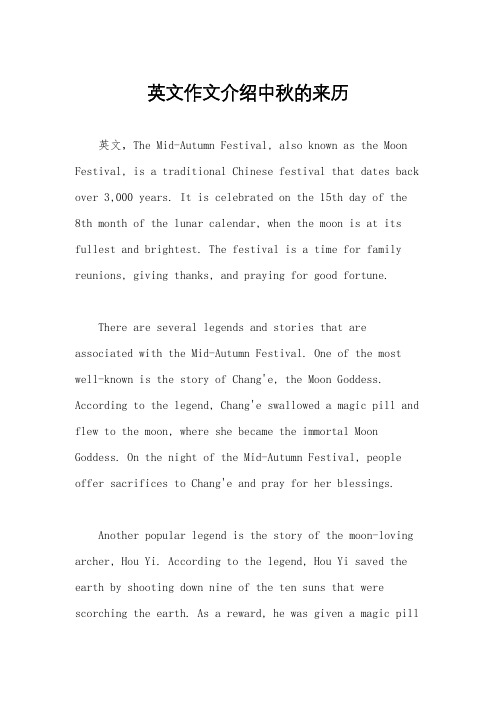
英文作文介绍中秋的来历英文,The Mid-Autumn Festival, also known as the Moon Festival, is a traditional Chinese festival that dates back over 3,000 years. It is celebrated on the 15th day of the8th month of the lunar calendar, when the moon is at its fullest and brightest. The festival is a time for family reunions, giving thanks, and praying for good fortune.There are several legends and stories that are associated with the Mid-Autumn Festival. One of the most well-known is the story of Chang'e, the Moon Goddess. According to the legend, Chang'e swallowed a magic pill and flew to the moon, where she became the immortal Moon Goddess. On the night of the Mid-Autumn Festival, people offer sacrifices to Chang'e and pray for her blessings.Another popular legend is the story of the moon-loving archer, Hou Yi. According to the legend, Hou Yi saved the earth by shooting down nine of the ten suns that were scorching the earth. As a reward, he was given a magic pillthat would make him immortal. However, his wife, Chang'e, stole the pill and swallowed it, causing her to fly to the moon.During the Mid-Autumn Festival, people gather withtheir families to admire the full moon and eat mooncakes, a traditional Chinese pastry filled with sweet bean paste, lotus seed paste, or salted egg yolks. It is also a timefor children to carry colorful lanterns and participate in various activities, such as lantern parades and moon-watching parties.中文,中秋节,又称月亮节,是一个源远流长的中国传统节日,可以追溯到3000多年前。
中秋节的历史英文介绍
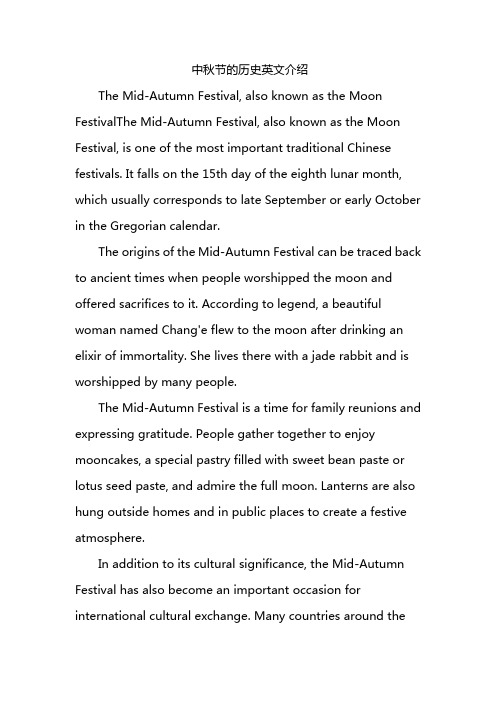
中秋节的历史英文介绍The Mid-Autumn Festival, also known as the Moon FestivalThe Mid-Autumn Festival, also known as the Moon Festival, is one of the most important traditional Chinese festivals. It falls on the 15th day of the eighth lunar month, which usually corresponds to late September or early October in the Gregorian calendar.The origins of the Mid-Autumn Festival can be traced back to ancient times when people worshipped the moon and offered sacrifices to it. According to legend, a beautiful woman named Chang'e flew to the moon after drinking an elixir of immortality. She lives there with a jade rabbit and is worshipped by many people.The Mid-Autumn Festival is a time for family reunions and expressing gratitude. People gather together to enjoy mooncakes, a special pastry filled with sweet bean paste or lotus seed paste, and admire the full moon. Lanterns are also hung outside homes and in public places to create a festive atmosphere.In addition to its cultural significance, the Mid-Autumn Festival has also become an important occasion for international cultural exchange. Many countries around theworld have embraced this festival and incorporated it into their own cultural traditions.译文中秋节,也被称为中秋节中秋节,也被称为中秋节,是中国最重要的传统节日之一。
中秋节的起源英文简单介绍
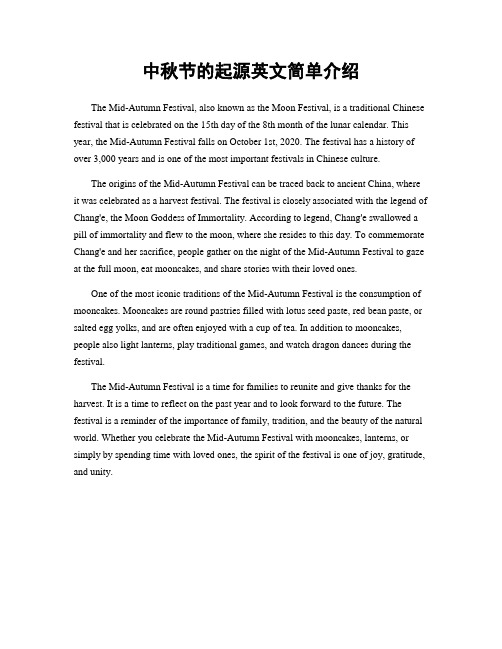
中秋节的起源英文简单介绍The Mid-Autumn Festival, also known as the Moon Festival, is a traditional Chinese festival that is celebrated on the 15th day of the 8th month of the lunar calendar. This year, the Mid-Autumn Festival falls on October 1st, 2020. The festival has a history of over 3,000 years and is one of the most important festivals in Chinese culture.The origins of the Mid-Autumn Festival can be traced back to ancient China, where it was celebrated as a harvest festival. The festival is closely associated with the legend of Chang'e, the Moon Goddess of Immortality. According to legend, Chang'e swallowed a pill of immortality and flew to the moon, where she resides to this day. To commemorate Chang'e and her sacrifice, people gather on the night of the Mid-Autumn Festival to gaze at the full moon, eat mooncakes, and share stories with their loved ones.One of the most iconic traditions of the Mid-Autumn Festival is the consumption of mooncakes. Mooncakes are round pastries filled with lotus seed paste, red bean paste, or salted egg yolks, and are often enjoyed with a cup of tea. In addition to mooncakes, people also light lanterns, play traditional games, and watch dragon dances during the festival.The Mid-Autumn Festival is a time for families to reunite and give thanks for the harvest. It is a time to reflect on the past year and to look forward to the future. The festival is a reminder of the importance of family, tradition, and the beauty of the natural world. Whether you celebrate the Mid-Autumn Festival with mooncakes, lanterns, or simply by spending time with loved ones, the spirit of the festival is one of joy, gratitude, and unity.。
- 1、下载文档前请自行甄别文档内容的完整性,平台不提供额外的编辑、内容补充、找答案等附加服务。
- 2、"仅部分预览"的文档,不可在线预览部分如存在完整性等问题,可反馈申请退款(可完整预览的文档不适用该条件!)。
- 3、如文档侵犯您的权益,请联系客服反馈,我们会尽快为您处理(人工客服工作时间:9:00-18:30)。
中秋节起源英文介绍
The Mid-Autumn Festival, also known as the Moon Festival, is a traditional Chinese holiday that is celebrated on the 15th day of the eighth lunar month. The festival is believed to have originated from ancient Chinese customs and legends.
One legend tells the story of a beautiful lady named Chang'e, who accidentally consumed the elixir of immortality and flew to the moon, where she became a goddess. To commemorate this legend, people gather on this day to admire the moon and celebrate with family and friends.
Another legend associated with the festival is the story of Houyi, a legendary archer who saved the world by shooting down nine out of ten suns that were scorching the earth. As a reward, Houyi was given the elixir of immortality, but his wife, Chang'e, ingested it instead and flew to the moon.
During the Mid-Autumn Festival, families come together to enjoy mooncakes, a traditional delicacy that symbolizes reunion and good fortune. These round pastries are usually filled with sweet lotus seed paste or red bean paste and often have a salted egg yolk in the center, representing the full moon. Mooncakes are exchanged as gifts among family members and friends.
In addition to mooncakes, people also enjoy other traditional foods such as pomelos, a type of citrus fruit, and various fruits and nuts. Lanterns are lit and carried during the festivities, adding a colorful and festive atmosphere to the celebration.
The Mid-Autumn Festival is not only celebrated in China but also in other East Asian countries such as Vietnam, Singapore, and Malaysia. It is a time for reunions and expressing gratitude for the abundance of the harvest season.
Overall, the Mid-Autumn Festival is a cherished holiday in Chinese culture, celebrating the legends of Chang'e and Houyi, while also serving as an occasion for families to come together and enjoy time with loved ones under the beautiful moonlit sky.。
